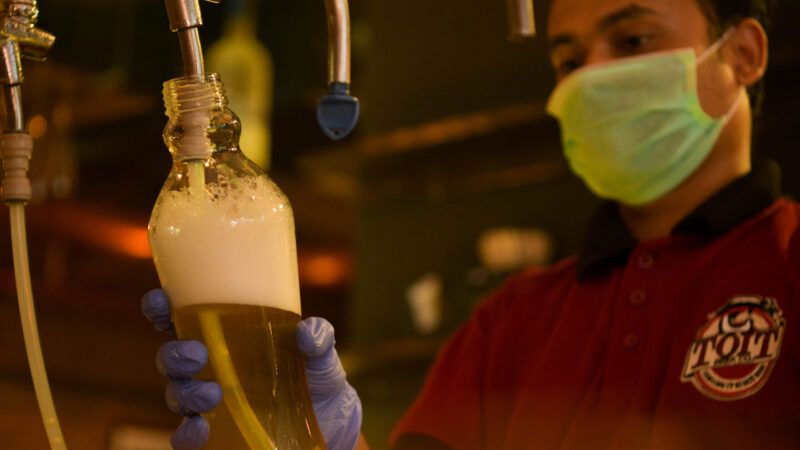'Transparency' Mandate Would Burden Small Brewers and Distilleries
Government pre-approval for every label could crush craft breweries. And do you really want to force the Carthusian monks who make Green Chartreuse to reveal their ingredients?

The Alcohol and Tobacco Tax and Trade Bureau (TTB) is considering new rules for alcohol labeling, including a mandate to display nutritional information and ingredients on booze bottles and cans. Some people are heralding this as a common-sense transparency reform. In fact, it's another combat theater in the government's war against alcohol.
In 2022, the TTB issued its "Competition in Markets for Beer, Wine, and Spirits" report, which recommended that the agency consider a new mandate to print nutritional information, ingredients, and food allergens on alcohol product labels. (Alcohol is not currently subject to nutritional and ingredient labeling mandates, since it falls within the ambit of the TTB rather than the Food and Drug Administration.) To judge from recent listening sessions hosted by the TTB (and some rumblings in the industry), the agency appears to be leaning toward taking the report's advice.
Groups like the Center for Science in the Public Interest and the Consumer Federation of America have been petitioning for mandatory labeling for more than two decades. After the 2022 report, these organizations sued the TTB to force it to move, citing a "nearly nineteen-year delay in responding to a 2003 petition." (Maybe bureaucratic inertia isn't always a bad thing?)
These two groups portray their goal as a simple and unobjectionable pursuit of "enhanced transparency," a "commonsense step" that can not only help "address the health and safety concerns related to the consumption of alcohol" but also "allow consumers to make informed choices about the alcoholic products they purchase."
It's hard to oppose "transparency," "common sense," and "informed choices." But labeling mandates always fall heaviest on the smallest of businesses.
The concept of nutritional and ingredient labeling is even more complex in the alcohol space since the TTB uses a pre-approval system for alcohol labeling, meaning that alcohol producers have to submit their proposed labels to the agency for approval before the product ever hits the market. No approval, no market access. This is in marked contrast to most food labeling, which the Food and Drug Administration enforces after a product goes to market.
Not only are most craft breweries, distilleries, and wineries small, local businesses, but much of their appeal is the ever-changing array of products that they offer. Some of the most cutting-edge and popular microbreweries in America release multiple new beers per week or month alongside seasonal releases that vary in availability depending on the time of year.
Breweries often release annual products, such as Christmas Ales, that use the same base set of spices but may have some small variations and tweaks from year to year. If these mandates are in place, a brewery could face the prospect of having to get new labels preapproved every single year, a time and cost burden that few small breweries could absorb.
In the distilling process, products that go in at the front end are sometimes stripped out during the distillation. Do these products need to go on the ingredients label? If so, at what trace level is an ingredient deemed significant enough to be included? (Even outside the alcohol context, nutritional labels rely on arbitrary delineations and assumptions). Would the government accept labels featuring QR codes, so producers can make changes without triggering the pre-approval process for a whole new label?
And what should regulators do with specialty spirits like the legendary Green Chartreuse? Green Chartreuse, which is made by a group of Carthusian monks in the alps, has 130 different herbs and plants in it—and, famously, only two of the monks know the full proprietary recipe. Do these two brothers have to cough up a full ingredients list?
It is very easy for seemingly "commonsense" transparency reform to give way to more alarmist and intense health warnings on booze and, eventually, more draconian restrictions on alcohol sales and higher booze taxes.
Meanwhile, much of the alcohol industry is already adopting voluntary labeling practices, with most of the larger companies—who can afford it—including such information anyway.
Consumers who are concerned about the amount of sugar in their hard seltzer or the exact ingredients in their beer can find plenty of options on the shelf that contain such information. Consumers who don't care should be free to buy what they want.


Show Comments (260)